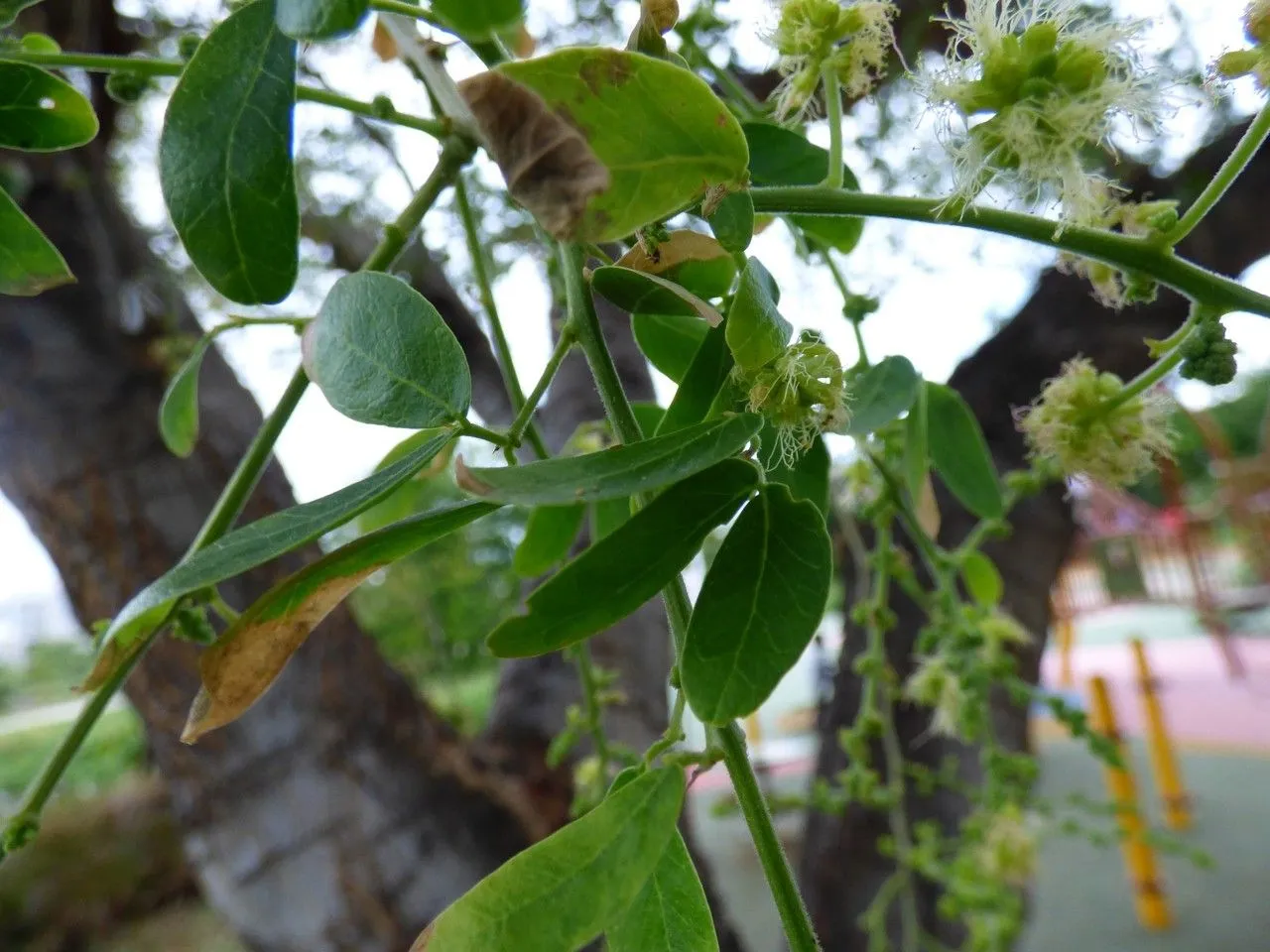
Author: (Roxb.) Benth.
Bibliography: London J. Bot. 3: 199 (1844)
Year: 1844
Status: accepted
Rank: species
Genus: Pithecellobium
Vegetable: False
Observations: Mexico to Guyana and Peru
The Manila-tamarind, scientifically known as Pithecellobium dulce, is a unique and fascinating member of the Fabaceae family. Originally documented in the 1844 volume of the London Journal of Botany by the botanist (Roxb.) Benth., this resilient plant has since established itself across a wide geographical range extending from Mexico to Guyana and Peru.
This versatile species is valued for its distinct appearance and hardy nature. The Manila-tamarind typically manifests as a small to medium-sized tree, showcasing an appealing canopy of delicate, feathery leaves. Its branches often display a curious zigzag pattern, adding to the tree’s ornamental charm.
One of the most distinctive features of Pithecellobium dulce is its fruit. Encased in coiled, pod-like structures, the seeds are surrounded by a pulpy, edible aril that is profoundly sweet, which may explain the common name “tamarind,” despite being botanically different from the true tamarind, Tamarindus indica. The sweet aril is not only a delight to the taste buds but also a source of nutrition, making it a popular treat in local cuisine across its native range.
The Manila-tamarind’s resilience is noteworthy. It thrives in a variety of soil types and climatic conditions, making it a favored choice for reforestation and ornamental planting in many tropical and subtropical regions. This adaptability contributes to its widespread presence from Mexico through Guyana and into parts of Peru.
Beyond its ecological and aesthetic value, Pithecellobium dulce plays a significant role in traditional medicine. Various parts of the plant, including its bark, leaves, and seeds, are utilized in folk remedies, treating ailments such as gum inflammation, digestive disorders, and even skin conditions.
In summary, the Manila-tamarind is a multifaceted plant with much to offer. Its sweet fruits, robust adaptability, and medicinal properties underscore its prominence within the Fabaceae family and its enduring relevance in the regions where it flourishes naturally.
Spa: buche, guamúchil, huamúchil, madre de flecha
Deu: camambilarinde
Eng: madrasthorn, manila-tamarind, monkeypod, blackbead, camachile, guayamochil, sweet-inga
Por: acácia-mimosa
Fra: pois sucré
En: Manila-tamarind, Camachile, Guayamochil, Madrasthorn, Blackbead, Sweet-inga, Monkeypod, Black beard, Cassie Manie, Cassie de Manille, Guama Americano, Madras Thorn, Manila Tamarind, Manilla Tamarind, Gaumuchil apes-earring, Kamachil wood, Sweet inga, Tamarind
Ar: غاف البحر
Bn: খইয়া বাবলা
Zh: 牛蹄豆
Fi: Meksikonapinanpalko
Fr: Pois sucré, Bois traînant, Pithécellobium doux, Tamarin d’Inde, Bois Noir de l’Inde
De: Camambilarinde
Hi: पिथोस्बॉबियम डूलस
Km: អំពិលទឹក
Lt: Saldžioji beždžionpupė
Ml: മാനിലപ്പുളി
Mr: विलायती चिंच
Ne: जलेबी
Or: ଶିମକଇଁଆ
Fa: تمبر هندی مانیلا
Pt: Acácia-mimosa
Es: Guamúchil, Madre de flecha, Huamúchil, Buche, Michiguiste, Dinde, Yacure, Aabache, Chiminango, Guamo americano, Guamuchil, Inga dulce, Jaguay, Muchite, Ojito de nena, Tierra espina
Tl: Kamatsile
Zh-tw: 牛蹄豆
Ta: கொடுக்காய்ப்புளி
Te: సీమ చింత
Th: มะขามเทศ
Vi: Me nước
Taken Jun 13, 2016 by Hugo SANTACREU (cc-by-sa)
Taken Dec 14, 2016 by Hugo SANTACREU (cc-by-sa)
Taken Jun 20, 2022 by Trap Hers (cc-by-sa)
Taken Dec 14, 2016 by Hugo SANTACREU (cc-by-sa)
Taken Aug 28, 2017 by Tela Botanica − Sylvain PIRY (cc-by-sa)
© copyright of the Board of Trustees of the Royal Botanic Gardens, Kew.
© copyright of the Board of Trustees of the Royal Botanic Gardens, Kew.
© copyright of the Board of Trustees of the Royal Botanic Gardens, Kew.
Taken Jun 20, 2022 by Trap Hers (cc-by-sa)
Taken Aug 28, 2017 by Tela Botanica − Sylvain PIRY (cc-by-sa)
Taken Aug 28, 2017 by Tela Botanica − Sylvain PIRY (cc-by-sa)
Taken Jan 18, 2006 by Tela Botanica − Liliane Roubaudi (cc-by-sa)
Taken Oct 21, 2019 by Gio974 (cc-by-sa)
Taken Aug 28, 2017 by Tela Botanica − Sylvain PIRY (cc-by-sa)
Taken Mar 16, 2022 by Naushad BM (cc-by-sa)
Taken Dec 14, 2016 by Hugo SANTACREU (cc-by-sa)
Taken Oct 26, 2021 by Raine (cc-by-sa)
Taken Jan 26, 2021 by D Kari (cc-by-sa)
Taken Jun 29, 2016 by Hugo SANTACREU (cc-by-sa)
Taken Oct 8, 2017 by Hugo SANTACREU (cc-by-sa)
Taken Oct 8, 2017 by Hugo SANTACREU (cc-by-sa)
Taken Jan 26, 2021 by D Kari (cc-by-sa)
Taken Mar 16, 2022 by Naushad BM (cc-by-sa)
Taken Jun 13, 2016 by Hugo SANTACREU (cc-by-sa)
Taken Jun 13, 2016 by Hugo SANTACREU (cc-by-sa)
Taken Jun 13, 2016 by Hugo SANTACREU (cc-by-sa)
Taken Mar 16, 2022 by Naushad BM (cc-by-sa)
Taken Aug 28, 2017 by Tela Botanica − Sylvain PIRY (cc-by-sa)
Taken Apr 13, 2021 by Jean-Marie Tognola (cc-by-sa)
Taken Oct 26, 2021 by Raine (cc-by-sa)
Taken Jan 26, 2021 by D Kari (cc-by-sa)
Taken Mar 16, 2022 by Naushad BM (cc-by-sa)
Growth habit: Tree, Shrub
Family: Myrtaceae Author: (F.Muell.) K.D.Hill & L.A.S.Johnson Bibliography: Telopea 6: 402 (1995) Year: 1995 Status:…
Family: Rubiaceae Author: Pierre ex A.Froehner Bibliography: Notizbl. Bot. Gart. Berlin-Dahlem 1: 237 (1897) Year:…
Family: Sapindaceae Author: Koidz. Bibliography: J. Coll. Sci. Imp. Univ. Tokyo 32(1): 38 (1911) Year:…
Family: Asteraceae Author: A.Gray Bibliography: Pacif. Railr. Rep.: 107 (1857) Year: 1857 Status: accepted Rank:…
Family: Fabaceae Author: Medik. Bibliography: Vorles. Churpfälz. Phys.-Ökon. Ges. 2: 398 (1787) Year: 1787 Status:…
Family: Aspleniaceae Author: (Cav.) Alston Bibliography: Bull. Misc. Inform. Kew 1932: 309 (1932) Year: 1932…